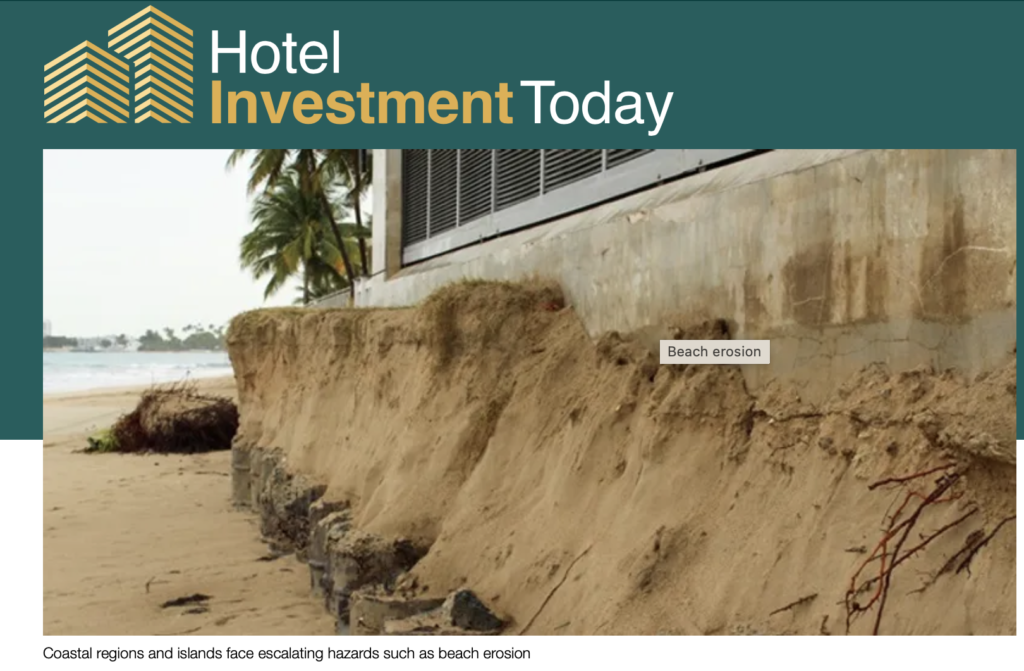Hotel Investment Today, By Adam Greenfader

The hospitality industry across the globe is undergoing significant new risks due to climate change. Coastal regions and islands (such as the Caribbean), face escalating hazards, profoundly impacting physical risks to beachfront real estate. These risks include the acceleration of beach erosion, increasing wind speeds, and rising tides.
Climatic changes are resulting in a rise in capital expenditures for repairs and renovations, higher outlays for ground-up development and diminishing insurance coverage. This combination is resulting in significant reductions to Net Operating Incomes (NOI). The good news is that as investors evaluate risks and opportunities, they now have a new set of tools for assessing the financial risks due to climate risks.
Top-down
In 2017, the G20 Finance Ministers and Central Bank Governors created the Taskforce on Climate Related Financial Disclosures (TCFD). The TCFD has developed a framework for climate-related financial disclosures to enhance understanding of material risks and support informed investment, lending, and insurance underwriting decisions.
The first financial standards were published in June of 2023, integrating and building on the recommendations of TCFD and incorporating industry-based disclosure requirements derived from sustainability accounting standards. This climate-related disclosures standard (IFRS S2) requires an entity to disclose information about climate-related risks and opportunities that could reasonably be expected to affect the entity’s cash flows and its access to finance or cost of capital.
Real estate comprised almost 11% of the non-financial companies participating in reporting, following the leading materials (33%) and consumer discretionary (22%) industries. There is specific industry-based guidance on implementing IFRS S2 for real estate, real estate services, hotels and lodging.
Physical risks and greenhouse gas emissions are the two main challenges for the hospitality sector. Understanding these risks is the first step in capital reallocation to a low carbon economic environment. Specific disclosures include board oversight, management’s role, risks and opportunities, impact on an organization, resilience of strategy, risk identification and assessment processes, risk management processes, and integration into overall risk management, among others.
Bottom-up
In addition to these “top-down” efforts to identify, evaluate, manage, and disclose climate risks, initiatives are emerging with “bottom-up” evaluations of real estate investments.
For example, hurricanes and tropical storms in the Caribbean result in costly repairs. In the past, these costs have been hard to quantify due to a lack of data. We all intuitively know that insurance costs historically go up after a storm and then recede a few years later. However, as storms are becoming “ever-present” there is a reduced predictability of insurance premiums and availability of coverage.
Today, better reporting across different regions and product types is creating more reliable financial models. In response to this challenge, some coastal engineering consultants use available numerical modeling tools to assess coastal storm hazards (including flooding and wave impacts) due to sea level rise and quantify coastal real estate risks over the investment period and climate risk drivers of the exit valuation.
ATM (A Geosyntec Company) in Florida has developed a tiered approach to coastal climate vulnerability and risk assessment, adaptation planning, and the analysis of implementation alternatives and their financial implications. This approach was built by ATM coastal engineering and numerical modeling experts using available tools, now used in a different way to respond to new requirements. It also incorporates financial modeling tools developed within Geosyntec to quantify the cost of risk in different types of projects, namely the DNPV methodology (Decoupled Net Present Value).
While this effort is more sophisticated than simple data analytics, it provides more and better information for decision-making. Research has also shown that data analytics can result in incorrect assessments of storm wave impacts considering sea level rise because databases for this type of coastal hazard are not readily available.
Detailed information and the understanding of risks at an asset level offer real estate stakeholders at all levels from developers to hotel managers, to even multi-property portfolio owners several advantages:
- Developers can make better-informed decisions by assessing specific site vulnerabilities and risks derived from the hotel design as part of a standard technical due diligence process.
- Hotel managers can formulate effective plans to minimize damage during extreme weather events, have shovel-ready plans to rebuild better, or clear policies to relocate facilities based on pre-defined triggers.
- Single asset managers and property owners can negotiate with insurance providers the best coverage and premiums based on documented risk reduction investments.
- Large portfolio managers can tailor global strategies based on the understanding of the risk profiles of each asset, diversifying portfolios to manage risk.
Convergence
Over time, the Taskforce on Climate Related Financial Disclosures will be included in all regulatory requirements (SEC, European Central Bank, U.S. Federal banking, etc.). Arguably, early adopters of bottom-up evaluations will have a competitive advantage in the hospitality sector: building a “hardened asset” will be more resilient, reduce costs of operations (energy, water, and other systems), and generate more protection in times of crisis.
In other words, by having a granular understanding of risk and value, a property will generate a better return on investment and higher property value and exit strategy.
Contributed by Adam Greenfader, chairman, AG&T, Miami/San Juan







